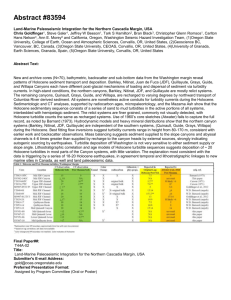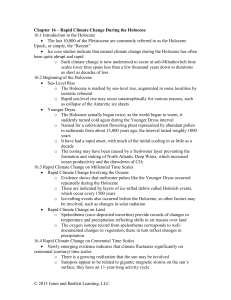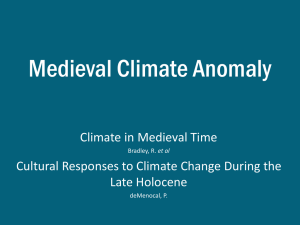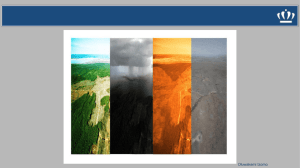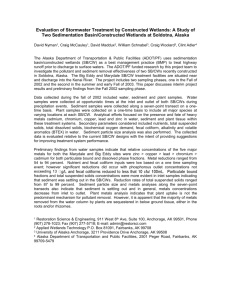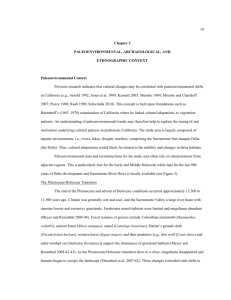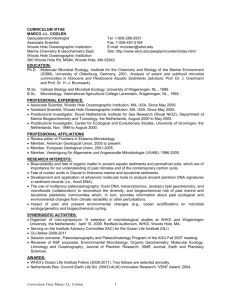Supplementary Discussion - Word file (55 KB )
advertisement
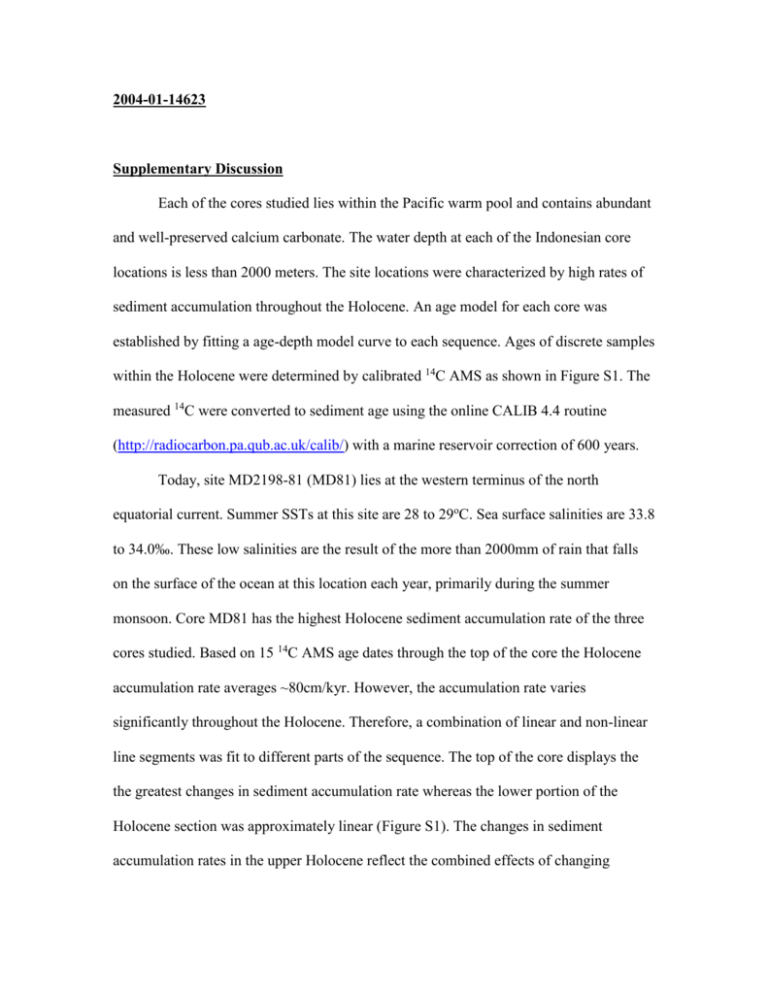
2004-01-14623 Supplementary Discussion Each of the cores studied lies within the Pacific warm pool and contains abundant and well-preserved calcium carbonate. The water depth at each of the Indonesian core locations is less than 2000 meters. The site locations were characterized by high rates of sediment accumulation throughout the Holocene. An age model for each core was established by fitting a age-depth model curve to each sequence. Ages of discrete samples within the Holocene were determined by calibrated 14C AMS as shown in Figure S1. The measured 14C were converted to sediment age using the online CALIB 4.4 routine (http://radiocarbon.pa.qub.ac.uk/calib/) with a marine reservoir correction of 600 years. Today, site MD2198-81 (MD81) lies at the western terminus of the north equatorial current. Summer SSTs at this site are 28 to 29oC. Sea surface salinities are 33.8 to 34.0‰. These low salinities are the result of the more than 2000mm of rain that falls on the surface of the ocean at this location each year, primarily during the summer monsoon. Core MD81 has the highest Holocene sediment accumulation rate of the three cores studied. Based on 15 14C AMS age dates through the top of the core the Holocene accumulation rate averages ~80cm/kyr. However, the accumulation rate varies significantly throughout the Holocene. Therefore, a combination of linear and non-linear line segments was fit to different parts of the sequence. The top of the core displays the the greatest changes in sediment accumulation rate whereas the lower portion of the Holocene section was approximately linear (Figure S1). The changes in sediment accumulation rates in the upper Holocene reflect the combined effects of changing sediment flux to the seabed and changing sediment compaction towards the top of the core. The MD81 core was sampled continuously at 1 to 2cm increments, providing a per sample resolution of between 15 and 30 years through most of the upper Holocene. The core is bioturbated so each sample integrates an accumulation of individual foraminifera that grew in surface waters for several weeks during the summer months. The sediment accumulation rate varies significantly among the three sites. Cores MD2198-70 and MD2198-76 have Holocene accumulation rates that average ~30cm/kyr and 50cm/kyr respectively. Site 70 is located between Australia and the southern most islands of the Indonesian archipelago and is within the path of Pacific through-flow to the Indian Ocean. The age model for MD70 is based on 4 calibrated AMS samples (not shown) and correlation to the other two MD sites. The measured Mg/Ca and δ18OPDB of Globigerinoides ruber values for each of the sites is given in the accompanying table (Supplementary Table 1). For Mg/Ca and 18O approximately 30 to 40 individual G. ruber (white variety) were picked from samples that had been washed through a 350um sieve with distilled water. The picked specimens were then cleaned using the trace metal cleaning technique applied to marine carbonate samples1. Spits of the cleaned sample were then analyzed for Mg and Ca by inductively coupled plasma atomic emission spectrometry. Our method for determining the Mg/Ca in foraminifera follows the method described by Schrag2, which involves a sequential analysis of a standard-sample-standard. Each sample Mg/Ca value is corrected based on the bracketed standard values. During the present study 23 replicate G. ruber samples were measured from site MD81. The standard deviation of these samples was 0.171mmol/mol. For 18O of calcite a split of the cleaned foraminifers were placed in stainless steel boats, loaded into an automated sample carousel for sequential acidification online. The CO2 evolved in the reaction was transferred to the inlet of a gas ratio stable isotope mass spectrometer cryogenically using routine procedures and the sample gas was compared to an internal standard gas sequentially 10 times. The difference in the 18O/16O of the sample and the internal standard is reported as a delta (δ18O) notation and with respect to the value of the universal PDB standard. Each automated batch of sample analyses includes a number of standard carbonates analyzed though out the automated run. Sample results were adjusted for any internal drift of an automated run. Our routine precision of 18O for standards run in conjunction with samples averaged ~0.10‰ over the course of the present study. Nine replicate G. ruber samples from MD81 yielded a standard deviation of 0.11‰. A sample from 7cm, near the top of Core MD9821-81 yielded an Mg/Ca value for G. ruber of 5.02mmol/mol. The estimated temperature for this value is 28.7 +/-1oC, which is the same as the average summer sea surface temperature at this location. The same sample yielded a 18Oc value of -2.67‰. When the temperature component (Mg/Ca temperature estimate) and 18Oc components are applied to the carbonate paleotemperature equation4,5 : Temperature (oC) = 16.5 – 4.80(18Oc – 18Ow), it predicts a 18Ow value of 0.2‰ (applying a 0.27‰ correction for the PDB to SMOW conversion)4. Surface salinities at this site today average 34.2‰ during summer 6. Epstein and Mayeda7 reported a 18OSMOW of 0.3‰ for surface water with a salinity of 34.3‰ at a site located at 134.50oE, 7.5oN, very close to site MD9821-81. The slope of the seawater 18O -salinity relationship from their small number of samples was ~0.2‰ per psu. Although there are only a limited number of 18O values for surface waters from sites in close proximity to the core locations, these results do indicate that a combined isotopeMg/Ca approach used here can yield a robust approximation of surface water 18OSMOW values. References: 1. Martin,P.A. & D. W. Lea, Geochem Geophys Geosyst 3, 8401, doi:10.1029/2001GC000280 (2002). 2. Schrag, D.P., Paleoceanography 14, 97-102 (1999) 3. Schmidt, G.A., G. R. Bigg and E. J. Rohling. (1999) http://www.giss.nasa.gov/data/o18data/ 4. Bemis, B.E. et al. Paleoceanography, 13, 150-160 (1998). 5. Thunell, R. et al., Geology, 27, 843-846 (1999). 6. World Ocean Atlas (2001) 7. Epstein, S., & Mayeda, T. K., Geochim. et Cosmochim Acta, v. 4, p. 213-224 (1953).
